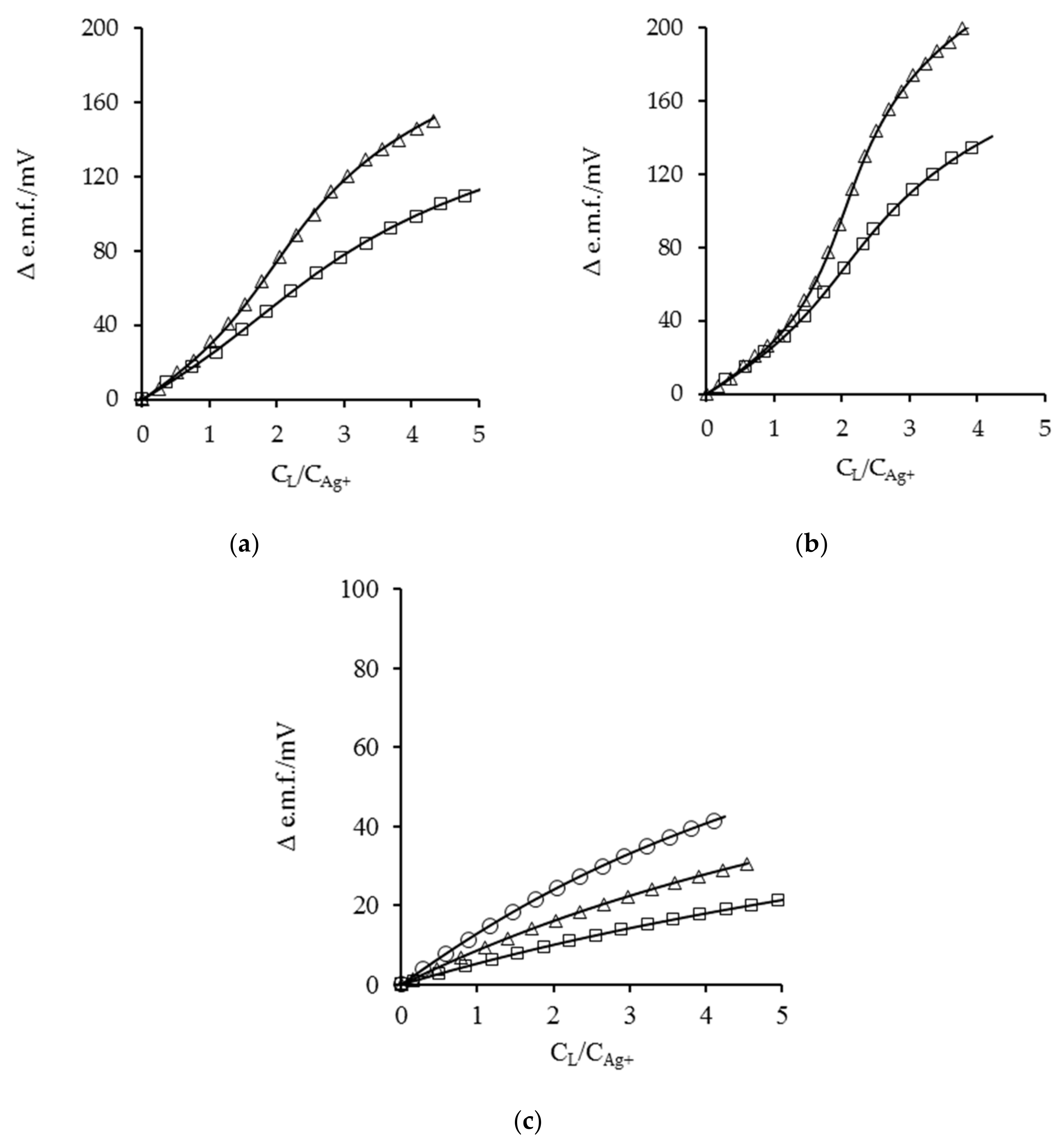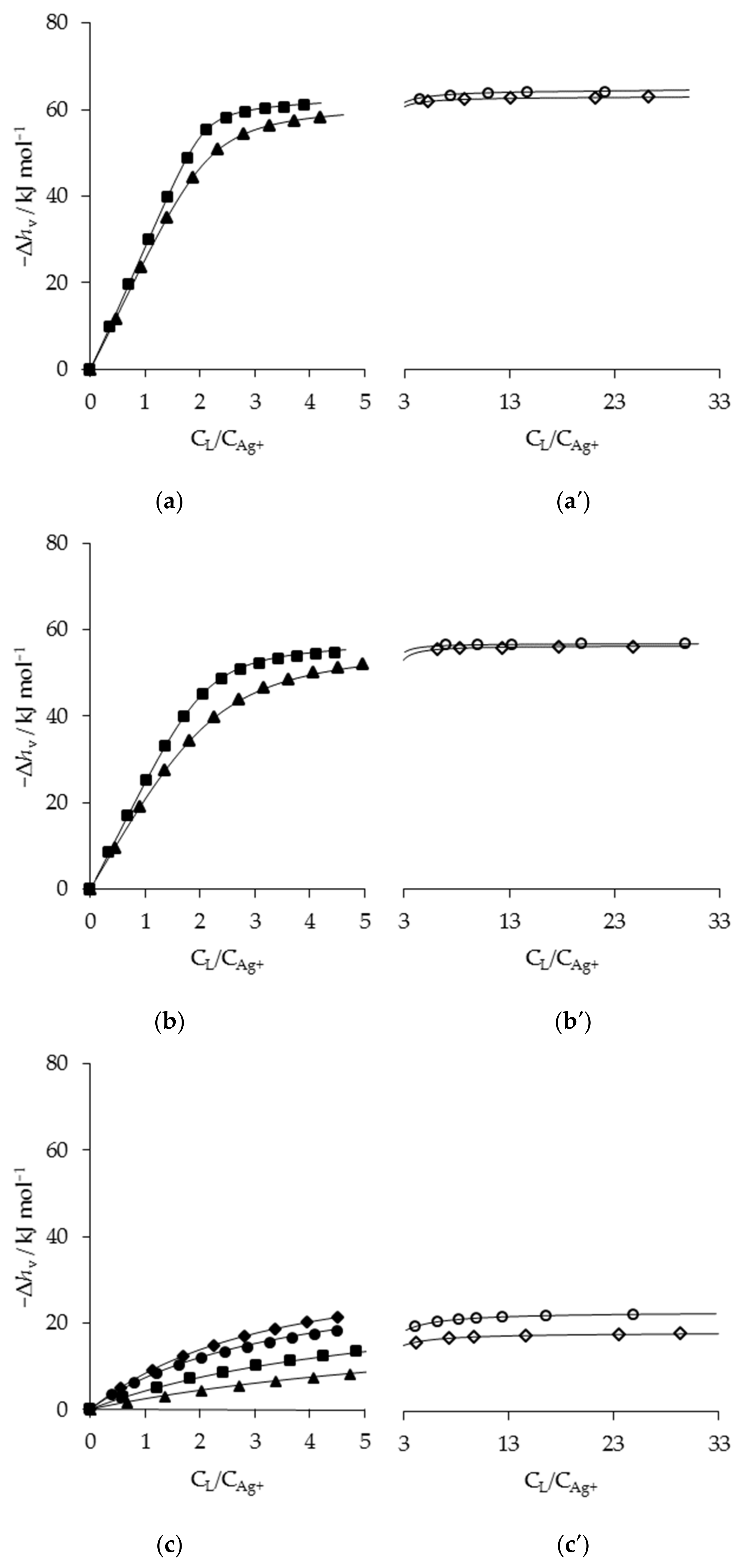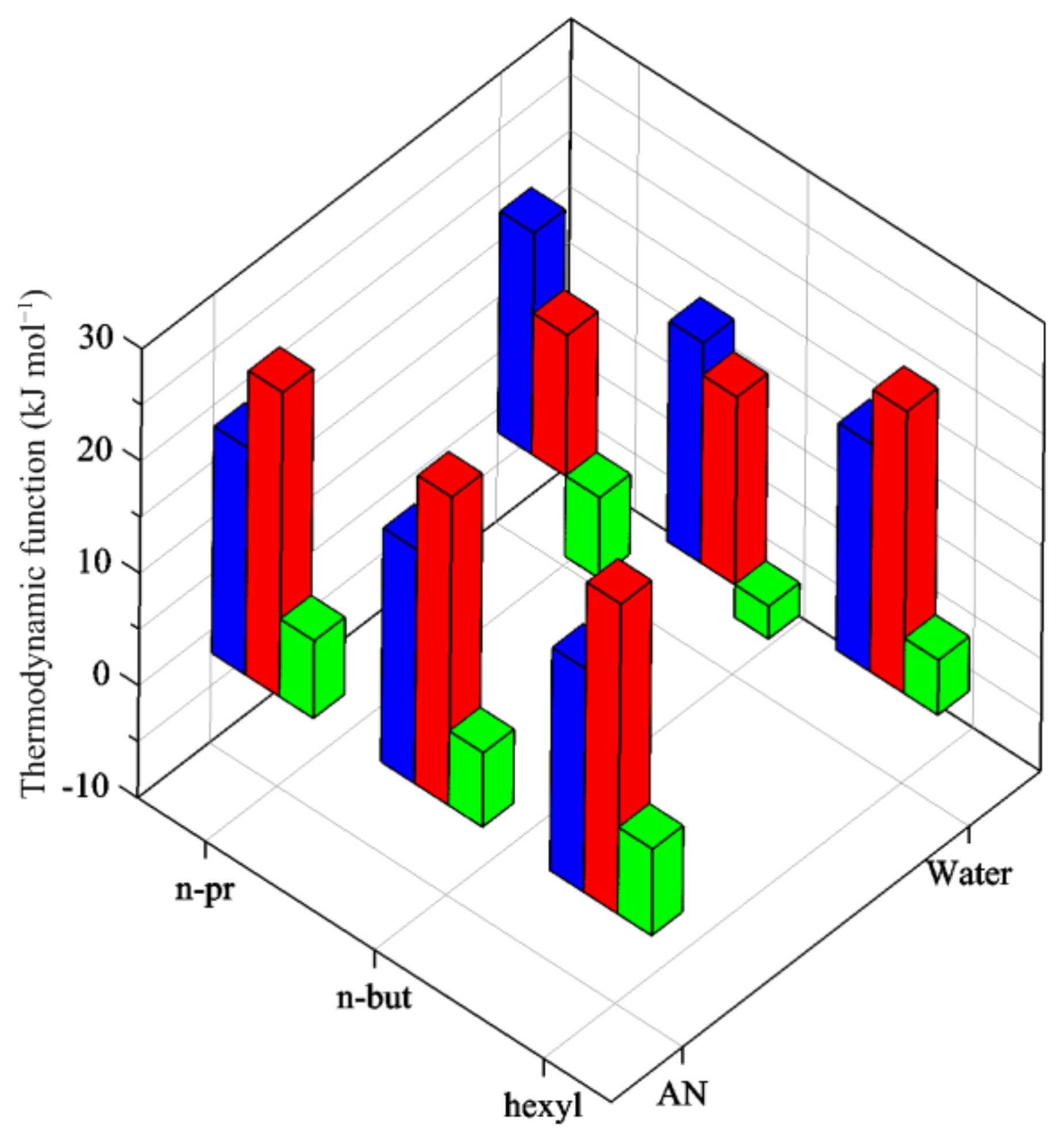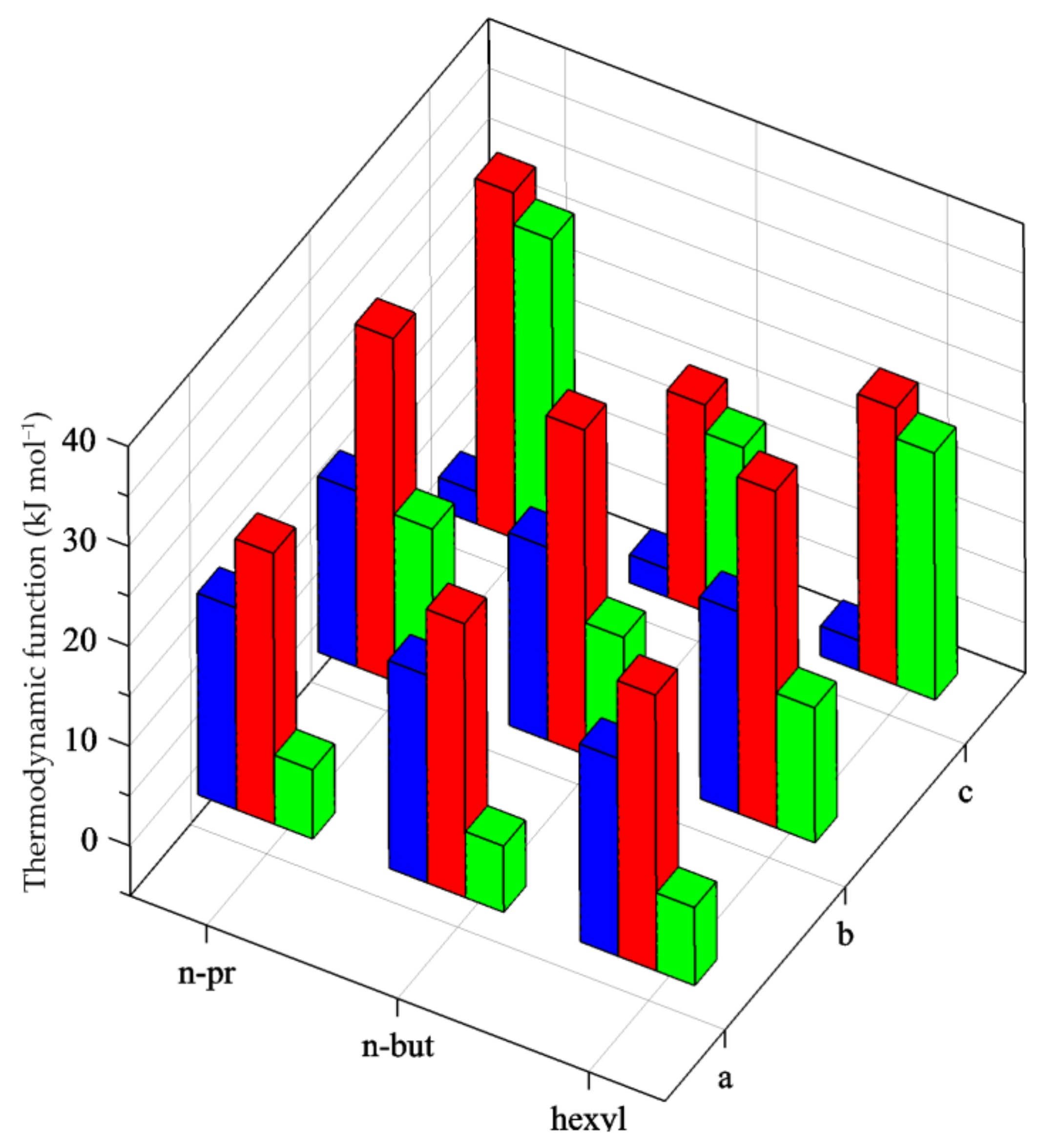Entropy and Enthalpy Effects on Metal Complex Formation in Non-Aqueous Solvents: The Case of Silver(I) and Monoamines
Abstract
:1. Introduction
2. Materials and Methods
2.1. Materials
2.2. Potentiometry
2.3. Calorimetry
3. Results and Discussion
4. Conclusions
Author Contributions
Funding
Institutional Review Board Statement
Informed Consent Statement
Data Availability Statement
Conflicts of Interest
References
- Smith, R.M.; Martell, A.E. Critical Stability Constants; Plenum Press: New York, NY, USA, 2004. [Google Scholar]
- Tiné, M.R. Cobalt Complexes in Aqueous Solutions as Dioxygen Carriers. Coord. Chem. Rev. 2012, 256, 316–327. [Google Scholar] [CrossRef]
- Piccinelli, F.; Leonzio, M.; Bettinelli, M.; Monari, M.; Grazioli, C.; Melchior, A.; Tolazzi, M. Tuning of the Sensing Properties of Luminescent Eu3+ Complexes towards the Nitrate Anion. Dalton Trans. 2016, 45, 3310–3318. [Google Scholar] [CrossRef] [PubMed]
- Piccinelli, F.; Bettinelli, M.; Melchior, A.; Grazioli, C.; Tolazzi, M. Structural, Optical and Sensing Properties of Novel Eu(III) Complexes with Furan- and Pyridine-Based Ligands. Dalton Trans. 2015, 44, 182–192. [Google Scholar] [CrossRef]
- Leonzio, M.; Melchior, A.; Faura, G.; Tolazzi, M.; Bettinelli, M.; Zinna, F.; Arrico, L.; Di Bari, L.; Piccinelli, F. A Chiral Lactate Reporter Based on Total and Circularly Polarized Tb(III) Luminescence. New J. Chem 2018, 42, 7931–7939. [Google Scholar] [CrossRef]
- Dau, P.V.; Zhang, Z.; Gao, Y.; Parker, B.F.; Dau, P.D.; Gibson, J.K.; Arnold, J.; Tolazzi, M.; Melchior, A.; Rao, L. Thermodynamic, Structural, and Computational Investigation on the Complexation between UO22+ and Amine-Functionalized Diacetamide Ligands in Aqueous Solution. Inorg. Chem. 2018, 57, 2122–2131. [Google Scholar] [CrossRef] [PubMed]
- Di Bernardo, P.; Melchior, A.; Tolazzi, M.; Zanonato, P.L. Thermodynamics of Lanthanide(III) Complexation in Non-Aqueous Solvents. Coord. Chem. Rev. 2012, 256, 328–351. [Google Scholar] [CrossRef]
- Di Bernardo, P.; Melchior, A.; Portanova, R.; Tolazzi, M.; Zanonato, P.L. Complex Formation of N-Donor Ligands with Group 11 Monovalent Ions. Coord. Chem. Rev. 2008, 252, 1270–1285. [Google Scholar] [CrossRef]
- Zanonato, P.L.; Melchior, A.; Busato, M.; Di Bernardo, P.; Tolazzi, M. Silver(I) Complexes with Long-Chain Diamines in Non-Aqueous Solvents. J. Therm. Anal. Calorim. 2019, 138, 3257–3265. [Google Scholar] [CrossRef]
- Zanonato, P.L.; Di Bernardo, P.; Melchior, A.; Tolazzi, M.; Polese, P.; Busato, M. Solvent and Structural Effects on Silver(I) Complex Formation: Thermodynamics and Modeling. J. Therm. Anal. Calorim. 2022, 147, 5501–5509. [Google Scholar] [CrossRef]
- Lippard, S.J.; Berg, J.M. Principles of Bioinorganic Chemistry; University Science Books: Mill Valley, CA, USA, 1994. [Google Scholar]
- Kaim, W.; Schwederski, B.; Klein, A. Bioinorganic Chemistry: Inorganic Elements in the Chemistry of Life; Wiley: New York, NY, USA, 2013. [Google Scholar]
- Nurchi, V.M.; Crisponi, G.; Lachowicz, J.I.; Zoroddu, M.A.; Peana, M.; Medici, S.; Veclani, D.; Tolazzi, M.; Melchior, A. Fluoroquinolones: A Micro-Species Equilibrium in the Protonation of Amphoteric Compounds. Eur. J. Pharm. Sci. 2016, 93, 380–391. [Google Scholar] [CrossRef]
- Nurchi, V.M.; de Guadalupe Jaraquemada-Pelaez, M.; Crisponi, G.; Lachowicz, J.I.; Cappai, R.; Gano, L.; Santos, M.A.; Melchior, A.; Tolazzi, M.; Peana, M.; et al. A New Tripodal Kojic Acid Derivative for Iron Sequestration: Synthesis, Protonation, Complex Formation Studies with Fe3+, Al3+, Cu2+ and Zn2+, and in Vivo Bioassays. J. Inorg. Biochem. 2019, 193, 152–165. [Google Scholar] [CrossRef] [PubMed]
- Fries, P.H.; Imbert, D.; Melchior, A. Determination of Outer-Sphere Dipolar Time Correlation Functions from High-Field NMR Measurements. Example of a Gd3+ Complex in a Viscous Solvent. J. Chem. Phys. 2010, 132, 044502. [Google Scholar] [CrossRef]
- Boros, E.; Holland, J.P.; Kenton, N.; Rotile, N.; Caravan, P. Macrocycle-Based Hydroxamate Ligands for Complexation and Immunoconjugation of 89Zirconium for Positron Emission Tomography (PET) Imaging. ChemPlusChem 2016, 81, 274–281. [Google Scholar] [CrossRef]
- Caravan, P.; Ellison, J.J.; McMurry, T.J.; Lauffer, R.B. Gadolinium(III) Chelates as MRI Contrast Agents: Structure, Dynamics, and Applications. Chem. Rev. 1999, 99, 2293–2352. [Google Scholar] [PubMed]
- Salbu, B.; Steinnes, E. Trace Elements in Natural Waters; CRC Press: Boca Raton, FL, USA, 1994. [Google Scholar]
- Bobba, S.; Carrara, S.; Huisman, J.; Mathieux, F.; Pavel, C. Critical Raw Materials for Strategic Technologies and Sectors in the EU—a Foresight Study; Office of the European Union: Luxembourg, 2020. [Google Scholar]
- Karak, N. Silver nanomaterials and their polymer nanocomposites. In Nanomaterials and Polymer Nanocomposites; Karak, N., Ed.; Elsevier: Amsterdam, The Netherlands, 2019; Chapter 2; pp. 47–89. [Google Scholar]
- Soukoulis, C.M.; Linden, S.; Wegener, M. Negative Refractive Index at Optical Wavelengths. Science 2007, 315, 47–49. [Google Scholar] [CrossRef] [PubMed]
- Pagliaro, M.; Della Pina, C.; Mauriello, F.; Ciriminna, R. Catalysis with Silver: From Complexes and Nanoparticles to MORALs and Single-Atom Catalysts. Catalysts 2020, 10, 1343. [Google Scholar] [CrossRef]
- Le, S.; Zhang, L.; Song, X.; He, S.; Yuan, Z.; Liu, F.; Zhang, N.; Sun, K.; Feng, Y. Review—Status of Zinc-Silver Battery. J. Electrochem. Soc. 2019, 166, A2980–A2989. [Google Scholar] [CrossRef]
- Syafiuddin, A.; Fulazzaky, M.A.; Salmiati, S.; Kueh, A.B.H.; Fulazzaky, M.A.; Salim, M.R. Silver Nanoparticles Adsorption by the Synthetic and Natural Adsorbent Materials: An Exclusive Review. Nanotechnol. Environ. Eng. 2020, 5, 1. [Google Scholar] [CrossRef]
- Liang, X.; Luan, S.; Yin, Z.; He, M.; He, C.; Yin, L.; Zou, Y.; Yuan, Z.; Li, L.; Song, X.; et al. Recent Advances in the Medical Use of Silver Complex. Eur. J. Med. Chem. 2018, 157, 62–80. [Google Scholar] [CrossRef]
- Tosato, M.; Asti, M.; Dalla Tiezza, M.; Orian, L.; Häussinger, D.; Vogel, R.; Köster, U.; Jensen, M.; Andrighetto, A.; Pastore, P.; et al. Highly Stable Silver(I) Complexes with Cyclen-Based Ligands Bearing Sulfide Arms: A Step Toward Silver-111 Labeled Radiopharmaceuticals. Inorg. Chem. 2020, 59, 10907–10919. [Google Scholar] [CrossRef]
- Li, W.; Adachi, T. Evaluation of Long-Term Silver Supply Shortage for c-Si PV under Different Technological Scenarios. Nat. Resour. Model. 2019, 32, e12176. [Google Scholar]
- Watari, T.; McLellan, B.C.; Giurco, D.; Dominish, E.; Yamasue, E.; Nansai, K. Total Material Requirement for the Global Energy Transition to 2050: A Focus on Transport and Electricity. Resour. Conserv. Recycl. 2019, 148, 91–103. [Google Scholar]
- Tchounwou, P.B.; Yedjou, C.G.; Patlolla, A.K.; Sutton, D.J. Heavy Metal Toxicity and the Environment. Exp. Suppl. 2012, 101, 133–164. [Google Scholar]
- Piccinelli, F.; Melchior, A.; Speghini, A.; Monari, M.; Tolazzi, M.; Bettinelli, M. Europium (III) Complexes with New N-Donor Ligand: A Comparative Study in Solid State and Solution. Polyhedron 2013, 57, 30–38. [Google Scholar]
- Melchior, A.; Tolazzi, M.; Polese, P.; Zanonato, P.L. Thermodynamics of Complex Formation of Silver(I) with N-Donor Ligands in Non-Aqueous Solvents. J. Therm. Anal. Calorim. 2017, 130, 461–469. [Google Scholar]
- Credendino, R.; Minenkov, Y.; Liguori, D.; Piemontesi, F.; Melchior, A.; Morini, G.; Tolazzi, M.; Cavallo, L. Accurate Experimental and Theoretical Enthalpies of Association of TiCl4 with Typical Lewis Bases Used in Heterogeneous Ziegler–Natta Catalysis. Phys. Chem. Chem. Phys. 2017, 19, 26996–27006. [Google Scholar]
- Busato, M.; D’Angelo, P.; Lapi, A.; Tolazzi, M.; Melchior, A. Solvation of Co2+ Ion in 1-Butyl-3-Methylimidazolium Bis(Trifluoromethylsulfonyl)Imide Ionic Liquid: A Molecular Dynamics and X-Ray Absorption Study. J. Mol. Liq. 2020, 299, 112120. [Google Scholar]
- Marcus, Y. The Properties of Solvents; Wiley: Hoboken, NJ, USA, 1999. [Google Scholar]
- Perrin, D.D.; Armarego, W.L.; Perrin, D.R. Purification of Laboratory Chemicals, 2nd ed.; Pergamon: Oxford, UK, 1980. [Google Scholar]
- Maass, G.; Jander, G. Die Grundlagen Der Chemie in Wasserfreier Essigsäure. In Fortschritte Der Chemischen Forschung; Springer: Berlin, Germany, 1953; Volume 2. [Google Scholar]
- Gans, P.; Sabatini, A.; Vacca, A. Investigation of Equilibria in Solution. Determination of Equilibrium Constants with the HYPERQUAD Suite of Programs. Talanta 1996, 43, 1739–1753. [Google Scholar] [CrossRef]
- Christensen, J.J.; Hansen, L.D.; Izatt, R.M. Handbook of Proton Ionization Heats and Related Thermodynamic Quantities; Wiley: New York, NY, USA, 1976. [Google Scholar]
- Arnek, R. High-Speed Computers as a Supplement to Graphical Methods, II: Application of LETAGROP to Calorimetric Titrations. Ark. Kemi 1970, 32, 81–88. [Google Scholar]
- Polese, P.; Tolazzi, M.; Melchior, A. CEST: A Flexible Tool for Calorimetric Data Analysis. J. Therm. Anal. Calorim. 2018, 134, 1317–1326. [Google Scholar]
- Hansen, L.D.; Temer, D.J. Effects of Hydrocarbon Chain Length on the Thermodynamics of Formation of Bis(n-Alkylamino)Silver(I) Complex Ions. Inorg. Chem. 1971, 10, 1439–1442. [Google Scholar] [CrossRef]
- Stroka, J.; Ossowski, T.; Cox, B.G.; Thaler, A.; Schneider, H. Influence of Pendant Cyanoalkyl Side-Arms on the Stabilities of Metal Ion Complexes of Monoaza- and Diaza-18-Crown-6 Ethers in Methanol. Inorg. Chim. Acta 1994, 219, 31–41. [Google Scholar]
- Garner, R.; Yperman, J.; Mullens, J.; Van Poucke, L.C. A potentiometric study of the complexation of aliphatic acyclic monoamine with Ag(I) in 1 M nitrate. J. Coord. Chem. 1993, 30, 151–164. [Google Scholar]
- Thaler, A.; Heidari, N.; Cox, B.G.; Schneider, H. Stability Constants of Copper(I) and Silver(I) Complexes with Open-Chain, Macrocyclic and -Bicyclic Aza-Ligands in Acetonitrile and Comparison with Results in Dimethylsulfoxide. Inorg. Chim. Acta 1999, 286, 160–168. [Google Scholar]
- Persson, I.; Nilsson, K.B. Coordination Chemistry of the Solvated Silver(I) Ion in the Oxygen Donor Solvents Water, Dimethyl Sulfoxide, and N,N‘-Dimethylpropyleneurea. Inorg. Chem. 2006, 45, 7428–7434. [Google Scholar]
- Tsutsui, Y.; Sugimoto, K.; Wasada, H.; Inada, Y.; Funahashi, S. EXAFS and Ab Initio Molecular Orbital Studies on the Structure of Solvated Silver(I) Ions. J. Phys. Chem. A 1997, 101, 2900–2905. [Google Scholar]
- Díaz-Moreno, S.; Muñoz-Páez, A.; Sánchez Marcos, E. X-Ray Absorption Spectroscopy Study of the In-Solution Structure of Ni2+, Co2+, and Ag+ Solvates in Acetonitrile Including Multiple Scattering Contributions. J. Phys. Chem. B 2000, 104, 11794–11800. [Google Scholar]
- Pliego, J.R. Car-Parrinello Molecular Dynamics Study of CuF, AgF, CuPF6 and AgPF6 in Acetonitrile Solvent and Cluster-Continuum Calculation of the Solvation Free Energy of Cu(I.), Ag(I) and Li(I). J. Mol. Liq. 2022, 359, 119368. [Google Scholar]
- Busato, M.; Melchior, A.; Migliorati, V.; Colella, A.; Persson, I.; Mancini, G.; Veclani, D.; D’Angelo, P. Elusive Coordination of the Ag+ Ion in Aqueous Solution: Evidence for a Linear Structure. Inorg. Chem. 2020, 59, 17291–17302. [Google Scholar]
- Marcus, Y. Ions in Solution and Their Solvation; John Wiley & Sons, Ltd.: Hoboken, NJ, USA, 2015. [Google Scholar]
- Robert, W. Taft Progress in Physical Organic Chemistry; John Wiley & Sons: Hoboken, NJ, USA, 1983; Volume 14. [Google Scholar]
- Semenov, I.M.; Repkin, G.I.; Sharnin, V.A. Thermodynamics of the Solvation and Phase Distributions of Ethylenediamine in Acetonitrile-Dimethylsulfoxide-Hexane Systems. Russ. J. Phys. Chem. A 2013, 87, 444–448. [Google Scholar]




| Amine | Solvent | Species | logβj | −ΔGj° | −ΔHj° | −TΔSj° |
|---|---|---|---|---|---|---|
| n-pr | AgL | 3.54 (16) | 20.2 (9) | 27.1 (4) | 6.9 | |
| AN | AgL2 | 6.92 (14) | 37.8 (8) | 61.4 (4) | 23.6 | |
| AgL3 | 7.19 (20) | 41.0 (1.1) | 96 (6) | 55 | ||
| n-but | AN | AgL | 3.65 (1) [8] | 20.8 (1) | 27.4 (1) | 6.6 |
| AgL2 | 7.04 (1) [8] | 40.1 (1) | 59.9 (1) | 19.8 | ||
| AgL3 | 7.53 (19) [8] | 42.9 (1.1) | 80.6 (7) | 37.7 | ||
| hexyl | AgL | 3.48 (13) | 19.8 (7) | 27.6 (8) | 7.8 | |
| AN | AgL2 | 7.02 (12) | 40.0 (7) | 61.3 (2) | 21.3 | |
| AgL3 | 7.54 (16) | 43.0 (4) | 89 (2) | 46 | ||
| n-but [8] | DMSO | AgL | 3.58 | 20.46 | 31.4 | 10.9 |
| AgL2 | 7.34 | 41.88 | 71.5 | 29.6 | ||
| n-but [8] | DMF | AgL | 4.80 | 27.4 | 36.3 | 8.9 |
| AgL2 | 9.59 | 54.7 | 86.5 | 31.8 | ||
| n-pr [41] | Water | AgL | 3.57 | 19.71 | 12.55 | −7.16 |
| AgL2 | 7.7 | 42.47 | 50.21 | 7.74 | ||
| n-but [41] | Water | AgL | 3.43 | 19.60 | 16.70 | −2.90 |
| AgL2 | 7.97 | 45.50 | 52.70 | 7.20 | ||
| hexyl [41] | Water | AgL | 3.66 | 20.21 | 25.10 | 4.89 |
| AgL2 | 7.83 | 43.18 | 54.39 | 11.21 |
| Amine | Solvent | Species | logβj | −ΔGj° | −ΔHj° | −TΔSj° |
|---|---|---|---|---|---|---|
| di-et | AN | AgL | 3.17 (12) | 18.0 (6) | 26.5 (2) | 8.5 |
| AgL2 | 6.03 (10) | 34.1 (3) | 58.5 (3) | 24.4 | ||
| di-pr | AN | AgL | 3.12 (1) | 17.8 (1) | 26.4 (4) | 8.6 |
| AgL2 | 5.87 (1) | 33.5 (1) | 57.9 (2) | 24.4 | ||
| di-but | AN | AgL | 3.14 (2) | 17.9 (2) | 27.9 (1) | 10 |
| AgL2 | 6.09 (1) | 34.7 (1) | 55.6 (2) | 20.9 | ||
| tri-et | AN | AgL | 2.20 (2) | 12.5 (2) | 23.8 (6) | 11.3 |
| AgL2 | 3.35 (2) | 19.3 (3) | 49.2 (9) | 29.9 | ||
| tri-pr | AN | AgL | 1.66 (8) | 9.4 (5) | 23.2 (8) | 13.8 |
| AgL2 | 2.45 (11) | 14.0 (6) | 42 (2) | 28 | ||
| di-but [8] | DMSO | AgL | 2.66 | 15.17 | 31.80 | 16.63 |
| AgL2 | 5.16 | 29.43 | 61.60 | 32.17 | ||
| tri-et [42] | PC | AgL | 7.83 | - | - | - |
| AgL2 | 10.83 | - | - | - | ||
| di-et [43] | Water | AgL | 3.11 | - | - | - |
| AgL2 | 6.43 | - | - | - | ||
| tri-et [43] | Water | AgL | 2.33 | - | - | - |
| AgL2 | 4.29 | - | - | - |
| ε | DN | ΔG°tr | ΔH°tr | TΔS°tr | |
|---|---|---|---|---|---|
| AN | 35.94 | 14.1 | - | - | - |
| PC | 64.92 | 15.1 | 42.9 | 4.2 | −38.7 |
| Water | 78.36 | 18.0 | 24.1 | 52.7 | 28.6 |
| DMF | 36.71 | 26.6 | 6.9 | 9 | 2.1 |
| DMSO | 46.45 | 29.8 | −7.9 | 1 | 8.9 |
Publisher’s Note: MDPI stays neutral with regard to jurisdictional claims in published maps and institutional affiliations. |
© 2022 by the authors. Licensee MDPI, Basel, Switzerland. This article is an open access article distributed under the terms and conditions of the Creative Commons Attribution (CC BY) license (https://creativecommons.org/licenses/by/4.0/).
Share and Cite
Melchior, A.; Sanadar, M.; Cappai, R.; Tolazzi, M. Entropy and Enthalpy Effects on Metal Complex Formation in Non-Aqueous Solvents: The Case of Silver(I) and Monoamines. Entropy 2022, 24, 1253. https://doi.org/10.3390/e24091253
Melchior A, Sanadar M, Cappai R, Tolazzi M. Entropy and Enthalpy Effects on Metal Complex Formation in Non-Aqueous Solvents: The Case of Silver(I) and Monoamines. Entropy. 2022; 24(9):1253. https://doi.org/10.3390/e24091253
Chicago/Turabian StyleMelchior, Andrea, Martina Sanadar, Rosita Cappai, and Marilena Tolazzi. 2022. "Entropy and Enthalpy Effects on Metal Complex Formation in Non-Aqueous Solvents: The Case of Silver(I) and Monoamines" Entropy 24, no. 9: 1253. https://doi.org/10.3390/e24091253
APA StyleMelchior, A., Sanadar, M., Cappai, R., & Tolazzi, M. (2022). Entropy and Enthalpy Effects on Metal Complex Formation in Non-Aqueous Solvents: The Case of Silver(I) and Monoamines. Entropy, 24(9), 1253. https://doi.org/10.3390/e24091253









